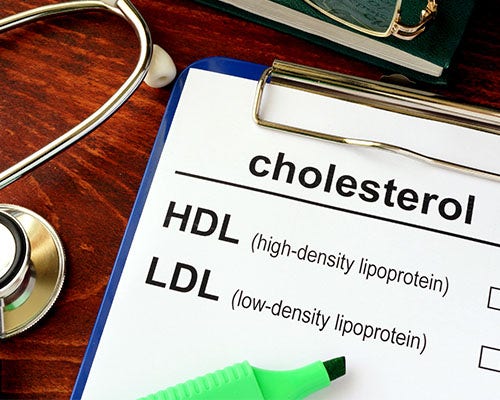Cholesterol—The Good, The Bad & The Ugly
- 10/10/17

Cholesterol can be a confusing and often misunderstood health topic. While cholesterol is necessary in the body to build cells, it can be difficult to remember the “good” versus the “bad” kinds and how much is “too much”. Many people are also often unsure how often to monitor their cholesterol levels to stay within a healthy range.
As reported by WebMD, statistics show that the average American has cholesterol levels that are ‘borderline high,’ and 1 in 6 people are at a high level. With data like this, it is especially important to understand how to properly manage cholesterol to avoid serious health complications.
What is Cholesterol?
Firstly, it helps to understand exactly what cholesterol is, how it is produced in the body, and the sources that can elevate levels above the normal limits. The National Institute of Health defines cholesterol into three categories—LDL (bad) cholesterol, HDL (good) cholesterol, and triglycerides. Collectively, these account for “total” cholesterol levels.
According to Healthline, LDL is referred to as a “bad” cholesterol because it leads to blockages in blood vessels, thus increasing the risk of heart disease. HDL is a “good” cholesterol because it helps remove the bad cholesterol from the arteries, helping prevent heart disease. Triglycerides are a form of fat in the blood that builds up in the body, which can raise the risk for heart disease. Therefore, it is ideal to keep LDL and triglycerides low, and HDL up for optimum health.
Causes of High Cholesterol
According to the American Heart Association, the liver makes all the cholesterol necessary for healthy functioning. When cholesterol levels become overly elevated, it is usually due to overconsumption of outside sources such as meat, poultry, full-fat dairy, many baked goods and palm oil. These foods are especially problematic because they are high in saturated and trans fat, causing the liver to make more cholesterol than it otherwise would.
According to MedlinePlus, factors that can affect healthy LDL levels include smoking, high blood pressure (140/90 mmHg or higher or on blood pressure medication), family history of early heart disease, and age (men 45 years or older; women 55 years or older at increased risk).
Risks of High Cholesterol
As previously mentioned, heart disease and its related complications are the most serious risks associated with high cholesterol. However, if additional health conditions are present such as high blood pressure or diabetes, the risk increases even more, says the American Heart Association. Excess cholesterol forms a thick, hard deposit which causes the arteries to narrow and become less flexible, known as atherosclerosis. Once this occurs, if a clot forms and blocks a narrowed artery, the result can be a heart attack or stroke.
How to Monitor Cholesterol Levels
WebMD recommends that cholesterol levels be measured via a blood test called a lipid profile at least once every five years in men and women over age 20. Men 35 and older and women 45 and older should be screened more frequently for lipid disorders.
The ideal range for total cholesterol (LDL and HDL) levels is less than 200mg/dL. Other factors do come into play such as the ratio of HDL to LDL, making a slightly higher total cholesterol level not a cause for major concern. This is why you need to be sure to discuss your levels in detail with your doctor.
How to Manage Cholesterol
Fortunately, high cholesterol is a highly controllable risk factor for coronary heart disease, heart attack, and stroke. Once a baseline of cholesterol levels is established, lifestyle modifications can be made that can help control high cholesterol. Typical management includes a combination of a healthy and balanced low-fat diet, regular exercise, and medications such as statins, says WebMD.
The National Institute of Health recommends that people looking to lower cholesterol use the Therapeutic Lifestyle Changes (TLC) approach, which is a holistic plan that incorporates the aforementioned diet, physical activity and weight management, and drug treatments.
Diet is of primary importance since saturated fat and cholesterol in foods elevate blood cholesterol levels, reducing the amount of saturated fat and cholesterol helps to lower them. In addition, obesity and excess weight increases the risk for heart disease, which compounds high cholesterol levels.
Lack of physical activity also increases the risk factor for cardiovascular problems. Regular physical activity can help lower LDL (bad) cholesterol and raise HDL (good) cholesterol levels, as well as support healthy weight management and weight loss. Experts recommend at least 30 minutes of daily activity.
When medications are necessary, proper healthy diet and exercise are still critical factors to maintain. Natural supplements and vitamins are also options, such as niacin, which helps to block the liver from removing HDL while also lowering triglycerides, as well as omega-3 fatty acids, which can increase the level of HDL while lowering triglycerides.
As reported by WebMD, statistics show that the average American has cholesterol levels that are ‘borderline high,’ and 1 in 6 people are at a high level. With data like this, it is especially important to understand how to properly manage cholesterol to avoid serious health complications.
What is Cholesterol?
Firstly, it helps to understand exactly what cholesterol is, how it is produced in the body, and the sources that can elevate levels above the normal limits. The National Institute of Health defines cholesterol into three categories—LDL (bad) cholesterol, HDL (good) cholesterol, and triglycerides. Collectively, these account for “total” cholesterol levels.
According to Healthline, LDL is referred to as a “bad” cholesterol because it leads to blockages in blood vessels, thus increasing the risk of heart disease. HDL is a “good” cholesterol because it helps remove the bad cholesterol from the arteries, helping prevent heart disease. Triglycerides are a form of fat in the blood that builds up in the body, which can raise the risk for heart disease. Therefore, it is ideal to keep LDL and triglycerides low, and HDL up for optimum health.
Causes of High Cholesterol
According to the American Heart Association, the liver makes all the cholesterol necessary for healthy functioning. When cholesterol levels become overly elevated, it is usually due to overconsumption of outside sources such as meat, poultry, full-fat dairy, many baked goods and palm oil. These foods are especially problematic because they are high in saturated and trans fat, causing the liver to make more cholesterol than it otherwise would.
According to MedlinePlus, factors that can affect healthy LDL levels include smoking, high blood pressure (140/90 mmHg or higher or on blood pressure medication), family history of early heart disease, and age (men 45 years or older; women 55 years or older at increased risk).
Risks of High Cholesterol
As previously mentioned, heart disease and its related complications are the most serious risks associated with high cholesterol. However, if additional health conditions are present such as high blood pressure or diabetes, the risk increases even more, says the American Heart Association. Excess cholesterol forms a thick, hard deposit which causes the arteries to narrow and become less flexible, known as atherosclerosis. Once this occurs, if a clot forms and blocks a narrowed artery, the result can be a heart attack or stroke.
How to Monitor Cholesterol Levels
WebMD recommends that cholesterol levels be measured via a blood test called a lipid profile at least once every five years in men and women over age 20. Men 35 and older and women 45 and older should be screened more frequently for lipid disorders.
The ideal range for total cholesterol (LDL and HDL) levels is less than 200mg/dL. Other factors do come into play such as the ratio of HDL to LDL, making a slightly higher total cholesterol level not a cause for major concern. This is why you need to be sure to discuss your levels in detail with your doctor.
How to Manage Cholesterol
Fortunately, high cholesterol is a highly controllable risk factor for coronary heart disease, heart attack, and stroke. Once a baseline of cholesterol levels is established, lifestyle modifications can be made that can help control high cholesterol. Typical management includes a combination of a healthy and balanced low-fat diet, regular exercise, and medications such as statins, says WebMD.
The National Institute of Health recommends that people looking to lower cholesterol use the Therapeutic Lifestyle Changes (TLC) approach, which is a holistic plan that incorporates the aforementioned diet, physical activity and weight management, and drug treatments.
Diet is of primary importance since saturated fat and cholesterol in foods elevate blood cholesterol levels, reducing the amount of saturated fat and cholesterol helps to lower them. In addition, obesity and excess weight increases the risk for heart disease, which compounds high cholesterol levels.
Lack of physical activity also increases the risk factor for cardiovascular problems. Regular physical activity can help lower LDL (bad) cholesterol and raise HDL (good) cholesterol levels, as well as support healthy weight management and weight loss. Experts recommend at least 30 minutes of daily activity.
When medications are necessary, proper healthy diet and exercise are still critical factors to maintain. Natural supplements and vitamins are also options, such as niacin, which helps to block the liver from removing HDL while also lowering triglycerides, as well as omega-3 fatty acids, which can increase the level of HDL while lowering triglycerides.




